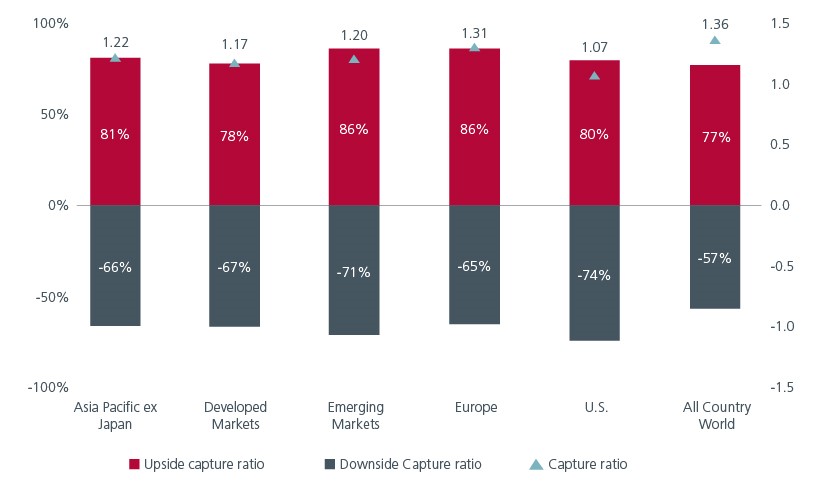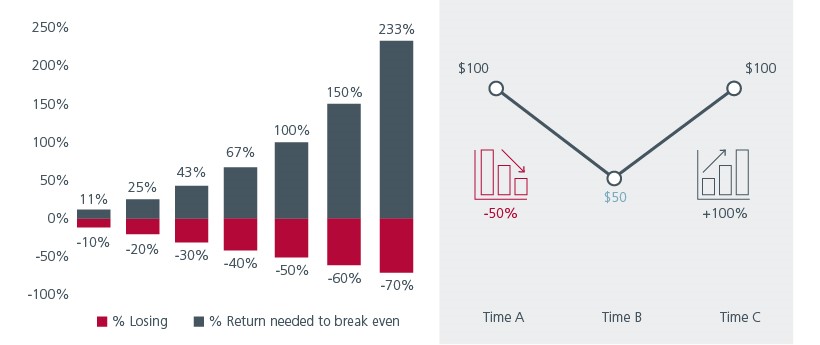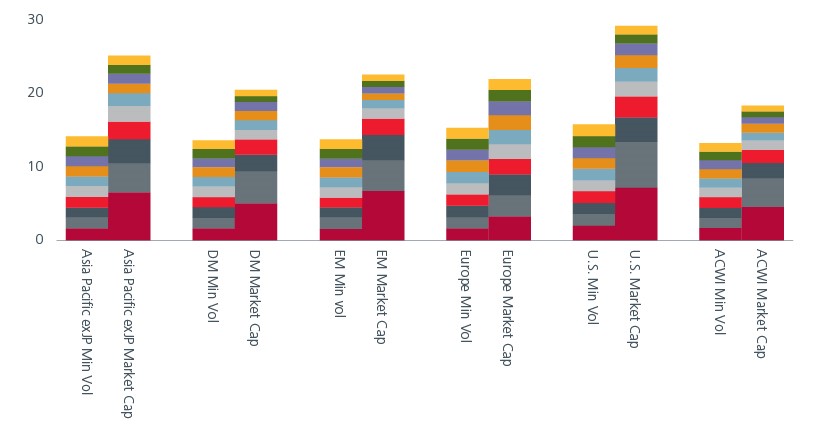Executive Summary
- Stay invested even in uncertain times with low volatility strategies that mitigate potential losses and reduce concentration risk.
- Over the full market cycles, stocks with lower volatility and correlation tend to deliver returns comparable to the broader equity market.
- Losing less during downturns while participating in market upswings gives low volatility investing its edge.
The story of the hare and the tortoise is a children’s favourite around the world. In the story, the persistent and determined tortoise unexpectedly wins a race against a fast but overconfident hare. While seemingly unrelated, the fable offers a valuable lesson to investors, particularly in today's volatile markets.
Many investors are drawn to the excitement and buzz around the latest "hare-like" stocks that dominate news and social media. However, such stocks can be unpredictable and risky. Research shows that investing in less exciting "tortoise-like" stocks, which exhibit steady (and often more predictable) growth over time, can be more effective in the long run. Focusing your portfolio on these stable and established companies is known as "low volatility investing" because it results in a portfolio with less variability in value over time.
Tortoise investing: Winning by losing less in turbulent markets
A low volatility portfolio helps to balance performance over time by losing less in negative market periods while still participating in positive market periods, albeit to a lesser extent than the broad market. This approach of losing less during downturns while participating in upswings gives low volatility investing its edge. Like the tortoise, a low volatility portfolio may not be the fastest, but it can ultimately win the race.
Fig. 1 shows the effect works across most major markets. Low volatility strategies have historically delivered a higher degree of upside capture—achieving gains during positive market phases— and a lower degree of downside capture, giving rise to superior risk-adjusted returns.
Fig 1: Asymmetry: Upside/Downside capture ratios across markets

Source: Upside and Downside Capture Ratio (LHS), Asymmetry Capture Ratio (RHS). Source: Eastspring Investments, MSCI, Bloomberg, December 2023. The upside/downside capture and asymmetry-capture ratio are calculated using MSCI AC Asia Pacific ex Japan Minimum Volatility Index, MSCI AC Asia Pacific ex Japan Index, MSCI World Minimum Volatility Index, MSCI World Index, MSCI EM Minimum Volatility Index, MSCI EM Index, MSCI Europe Minimum Volatility Index, MSCI Europe Index, MSCI USA Minimum Volatility Index, MSCI USA Index, MSCI ACWI Minimum Volatility Index, MSCI ACWI Index. All in USD. From 31st Jan 2002 to 29th Dec 2023.
Tortoise math: Compounding the benefits of low volatility
We have discussed the asymmetry in upside and downside capture in a low volatility portfolio but there is another dimension to this downside protection where the power of compounding truly shines. We illustrate this in Fig. 2.
Fig. 2: Illustration of return needed to break even after a downturn

Source: Eastspring Investments, Jan 2024
Consider a single share valued at USD100 at time A. If the market crashes and the share loses 50% of its value, it will drop to USD50 at time B. To return to its initial value of USD100, the share needs to gain not just 50%, but 100%, as it is starting from a lower base. This simple maths highlights the importance of minimising losses during downturns.
Although a high-growth stock may recover from a 50% drop, the 100% gain to break even puts immense pressure on its performance and exposes it to further risk if the recovery stumbles. In contrast, a low volatility “tortoise” stock, having suffered a smaller loss (e.g., 30% loss shown in the left illustration), only needs to climb 43% to reach its original USD100 value. This makes it less vulnerable to further tumbles and makes it easier to keep pace with the overall market over the long haul.
Lighten the load: Why weighting by volatility beats valuation
Recent years have seen an influx of investors into portfolios weighted by the market value of constituent companies (i.e., passive strategies). The idea is that other investors can do the hard work of valuing companies, and you can benefit by simply copying them with an implicit assumption that the market is efficiently capturing all available information in an unbiased manner.
However, as with any homework copying strategy, the key question is how good the student you are copying is! There is reason to believe that as more investors adopt these strategies, they can distort the market, causing prices to become detached from any rational valuation of the underlying company. It is like walking into a shop and declaring that you will pay whatever the shop owner asks—you are unlikely to get a good deal!
Low volatility portfolios do not suffer from this problem because they weight stocks based on volatility, not valuation; these portfolios do not mindlessly buy more of a company during a market mania.
Fig 3: Illustration of top 10 holdings weight (%) in min vol indices versus market cap

Source: DM: Developed Markets, EM: Emerging Markets, ACWI: All Country. Eastspring Investments, Top 10 holdings from MSCI AC Asia Pacific ex Japan Minimum Volatility Index, MSCI AC Asia Pacific ex Japan Index, MSCI World Minimum Volatility Index, MSCI World Index, MSCI EM Minimum Volatility Index, MSCI EM Index for Emerging Markets, MSCI Europe Minimum Volatility Index, MSCI Europe Index, MSCI USA Minimum Volatility Index, MSCI USA Index, MSCI ACWI Minimum Volatility Index, MSCI ACWI Index All in USD. As of 29th Dec 2023
This approach is complemented by diversification across sectors, countries, and stock levels, contributing to a well-rounded risk management strategy. Low volatility equity portfolios generally offer investors a smoother ride through the business cycle which makes it easier to maintain exposure to stocks and resist the siren voices of market timing.
Tortoise wisdom: The case for long-term, low-risk strategies
Global financial markets have weathered a series of significant shocks over the past few years, including the COVID-19 pandemic, geopolitical tensions like the Ukraine-Russia conflict, and high-profile banking collapses such as those of SVB and Credit Suisse. These events have contributed to a slowdown in overall economic growth, especially in China, and have led to sharp upward inflationary pressures and interest rate hikes. In addition, the emergence of new AI technologies has dominated markets as investors throw money at the stocks they expect will dominate the new era. This has led to extremes of market concentration in the market capitalisation indexes, as we discussed in our earlier article.
As we enter 2024, investors are facing a high degree of uncertainty, with ominous headlines dominating the news. The ongoing Ukraine-Russia conflict and Israel-Gaza conflict have led to volatility in crude oil prices across Brent and WTI. Additionally, lower growth and increased risk premiums in Chinese assets may lead to an overall decline in asset valuation and reduced capital inflows. Furthermore, developed markets are grappling with looming deficits, waning demand, and the possibility of recessions, while upcoming elections in the US and UK add to the overall sense of uncertainty.
It is crucial to remember that the stock market is a marathon, not a sprint. Low volatility strategies prioritise stability and loss avoidance, providing a steadier path towards financial goals even amidst market fluctuations.
We recommend that long-term investors consider exposure to low volatility solutions. By doing so, investors can maintain their equity exposure and capitalise on the long-term equity premium, while simultaneously mitigating potential losses, reducing concentration risk and diversifying performance sources in these uncertain times. Past experience suggests that this avoids some of the wild swings in valuation that are seen over a market cycle and leads to higher risk-adjusted returns.
The information and views expressed herein do not constitute an offer or solicitation to deal in shares of any securities or financial instruments and it is not intended for distribution or use by anyone or entity located in any jurisdiction where such distribution would be unlawful or prohibited. The information does not constitute investment advice or an offer to provide investment advisory or investment management service or the solicitation of an offer to provide investment advisory or investment management services in any jurisdiction in which an offer or solicitation would be unlawful under the securities laws of that jurisdiction.
Past performance and the predictions, projections, or forecasts on the economy, securities markets or the economic trends of the markets are not necessarily indicative of the future or likely performance of Eastspring Investments or any of the strategies managed by Eastspring Investments. An investment is subject to investment risks, including the possible loss of the principal amount invested. Where an investment is denominated in another currency, exchange rates may have an adverse effect on the value price or income of that investment. Furthermore, exposure to a single country market, specific portfolio composition or management techniques may potentially increase volatility.
Any securities mentioned are included for illustration purposes only. It should not be considered a recommendation to purchase or sell such securities. There is no assurance that any security discussed herein will remain in the portfolio at the time you receive this document or that security sold has not been repurchased.
The information provided herein is believed to be reliable at time of publication and based on matters as they exist as of the date of preparation of this report and not as of any future date. Eastspring Investments undertakes no (and disclaims any) obligation to update, modify or amend this document or to otherwise notify you in the event that any matter stated in the materials, or any opinion, projection, forecast or estimate set forth in the document, changes or subsequently becomes inaccurate. Eastspring Investments personnel may develop views and opinions that are not stated in the materials or that are contrary to the views and opinions stated in the materials at any time and from time to time as the result of a negative factor that comes to its attention in respect to an investment or for any other reason or for no reason. Eastspring Investments shall not and shall have no duty to notify you of any such views and opinions. This document is solely for information and does not have any regard to the specific investment objectives, financial or tax situation and the particular needs of any specific person who may receive this document.
Eastspring Investments Inc. (Eastspring US) primary activity is to provide certain marketing, sales servicing, and client support in the US on behalf of Eastspring Investment (Singapore) Limited (“Eastspring Singapore”). Eastspring Singapore is an affiliated investment management entity that is domiciled and registered under, among other regulatory bodies, the Monetary Authority of Singapore (MAS). Eastspring Singapore and Eastspring US are both registered with the US Securities and Exchange Commission as a registered investment adviser. Registration as an adviser does not imply a level of skill or training. Eastspring US seeks to identify and introduce to Eastspring Singapore potential institutional client prospects. Such prospects, once introduced, would contract directly with Eastspring Singapore for any investment management or advisory services. Additional information about Eastspring Singapore and Eastspring US is also is available on the SEC’s website at www.adviserinfo.sec. gov.
Certain information contained herein constitutes "forward-looking statements", which can be identified by the use of forward-looking terminology such as "may", "will", "should", "expect", "anticipate", "project", "estimate", "intend", "continue" or "believe" or the negatives thereof, other variations thereof or comparable terminology. Such information is based on expectations, estimates and projections (and assumptions underlying such information) and cannot be relied upon as a guarantee of future performance. Due to various risks and uncertainties, actual events or results, or the actual performance of any fund may differ materially from those reflected or contemplated in such forward-looking statements.
Eastspring Investments companies (excluding JV companies) are ultimately wholly-owned / indirect subsidiaries / associate of Prudential plc of the United Kingdom. Eastspring Investments companies (including JV’s) and Prudential plc are not affiliated in any manner with Prudential Financial, Inc., a company whose principal place of business is in the United States of America.















